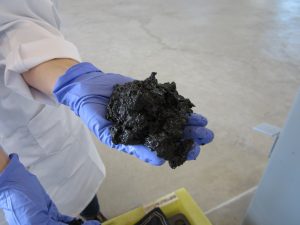Researchers at the U.S. Department of Energy’s Pacific Northwest National Laboratory (PNNL) have discovered the key to converting sewage to biocrude oil. Using the technology that mimics the geological conditions the Earth uses to create crude oil, called hydrothermal liquefaction, coupled with high pressure and high temperatures, crude oil can be produced in minutes. The resulting product is similar to petroleum pumped out of the ground with a minimal amount of water and oxygen mixed in. Once produced, the biocrude can then be refined using conventional petroleum refining operations.

Sludge from Metro Vancouver’s wastewater treatment plant has been dewatered prior to conversion to biocrude oil at Pacific Northwest National Laboratory.
Courtesy of WE&RF.
Sewage, or more specifically sewage sludge, has long been viewed as a poor ingredient for producing biofuel because it’s too wet. The approach being studied by the PNNL team eliminates the need for drying required in a majority of current thermal technologies which historically has made wastewater to fuel conversion too energy intensive and expensive. HTL may also be used to make fuel from other types of wet organic feedstock, such as agricultural waste.
Using hydrothermal liquefaction, organic matter such as human waste can be broken down to simpler chemical compounds. The research team pressurized the material to 3,000 pounds per square inch — nearly one hundred times that of a car tire. The pressurized sludge then goes into a reactor system operating at about 660 degrees Fahrenheit. The heat and pressure cause the cells of the waste material to break down into different fractions — biocrude and an aqueous liquid phase.
“There is plenty of carbon in municipal waste water sludge and interestingly, there are also fats,” said Corinne Drennan, who is responsible for bioenergy technologies research at PNNL. “The fats or lipids appear to facilitate the conversion of other materials in the wastewater such as toilet paper, keep the sludge moving through the reactor, and produce a very high quality biocrude that, when refined, yields fuels such as gasoline, diesel and jet fuels.”
Along with the biocrude, the liquid phase can be treated with a catalyst to create other fuels and chemical products. A small amount of solid material is also generated, which contains important nutrients. For example, early efforts have demonstrated the ability to recover phosphorus, which can replace phosphorus ore used in fertilizer production.
In addition to producing useful fuel, HTL could give local governments significant cost savings by virtually eliminating the need for sewage residuals processing, transport and disposal. “The best thing about this process is how simple it is,” said Drennan. “The reactor is literally a hot, pressurized tube. We’ve really accelerated hydrothermal conversion technology over the last six years to create a continuous, and scalable process which allows the use of wet wastes like sewage sludge.”
An independent assessment for the Water Environment & Reuse Foundation calls HTL a highly disruptive technology that has potential for treating wastewater solids. WE&RF investigators noted the process has high carbon conversion efficiency with nearly 60 percent of available carbon in primary sludge becoming bio-crude. The report calls for further demonstration, which may soon be in the works.
PNNL has licensed its HTL technology to Utah-based Genifuel Corporation, which is now working with Metro Vancouver, a partnership of 23 local authorities in British Columbia, Canada, to build a demonstration plant.

